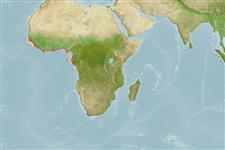Environment: milieu / climate zone / نطاق العمق / distribution range
البيئة
بحري; المياه العذبة; مياه مخلوطة pelagic-neritic; نطاق العمق 0 - 35 m (Ref. 86940). Tropical; 17°N - 7°S, 17°W - 14°E (Ref. 54448)
Africa: Atlantic coasts from northern parts of Senegal south to Baie de Saint-Bras in Angola (Ref. 188, 3509), also in lagoons and river estuaries (Ref. 188, 81270).
Length at first maturity / الحجم / وزن / العمر
النضج: Lm 13.0, range 13 - 18 cm
Max length : 30.0 cm SL ذكر/ مختلط الجنس; (Ref. 27000); common length : 16.0 cm SL ذكر/ مختلط الجنس; (Ref. 188); أعلا وزن تم نشرة: 144.00 g (Ref. 86940)
الأشواك الظهرية (المجموع) : 0; الأشعة الظهرية الناعمة (المجموع) : 14 - 17; شوكة شرجية: 0; أشعه شرجية لينه: 45 - 50; فقرات: 42 - 43. Diagnosis: Body moderately deep, compressed, belly with a sharp and serrated keel of scutes from gill opening to anus, 25-27 pre-pelvic and 6-8 post-pelvic sharp scutes (Ref. 187, 188, 81270). Eye large, mouth pointing upwards, lower jaw projecting (Ref. 187, 188). Dorsal fin at or before midpoint of body; anal fin long, with more than 40 finrays, its origin below dorsal fin base; pelvic fins small (Ref. 187, 188). Swimbladder with two short tubes passing back in the muscles on either side of haemal spines (Ref. 188). Other clupeoid fishes in the area are more slender, have a much shorter anal fin and the lower jaw is not strongly projecting (Ref. 188).
Body shape (shape guide): fusiform / normal; Cross section: compressed.
Found in the marine environment, pelagic, along beaches and just off shore, down to about 25 m, also in lagoons and estuaries, penetrating into almost freshwater (Ref. 187, 188, 54448). A marine migrant (Ref. 117399). Rarely found below 35 m depth (Ref. 86940). It feeds on small planktonic animals, e.g. small fish and crustaceans; it doesn't seem to feed on plankton (Ref. 188, 3166, 47405).
Whitehead, P.J.P., 1985. FAO Species Catalogue. Vol. 7. Clupeoid fishes of the world (suborder Clupeoidei). An annotated and illustrated catalogue of the herrings, sardines, pilchards, sprats, shads, anchovies and wolf-herrings. FAO Fish. Synop. 125(7/1):1-303. Rome: FAO. (Ref. 188)
IUCN Red List Status (Ref. 130435: Version 2025-1)
استخدامات بشرية
مصائد: تجاري
أدوات
تقارير خاصة
Download XML
مصادر علي الأنترنت
Estimates based on models
Preferred temperature (مرجع
123201): 25.9 - 28, mean 27.5 °C (based on 160 cells).
Phylogenetic diversity index (مرجع
82804): PD
50 = 0.5000 [Uniqueness, from 0.5 = low to 2.0 = high].
Bayesian length-weight: a=0.00676 (0.00557 - 0.00821), b=3.02 (2.97 - 3.07), in cm total length, based on LWR estimates for this species (Ref.
93245).
مستوى غذائي (مرجع
69278): 3.6 ±0.2 se; based on diet studies.
المرونه (مرجع
120179): عالي, الحد الزمني الأدني لتضاعف عدد أفراد المجتمع أقل من 15 شهر (K=0.8-1.3).
Prior r = 1.19, 95% CL = 0.79 - 1.79, Based on 3 data-limited stock assessments.
Fishing Vulnerability (Ref.
59153): Low vulnerability (21 of 100).
🛈
Climate Vulnerability (Ref.
125649): High to very high vulnerability (73 of 100).
🛈
Nutrients (Ref.
124155): Calcium = 206 [110, 411] mg/100g; Iron = 2.01 [1.19, 3.28] mg/100g; Protein = 19.4 [18.0, 20.7] %; Omega3 = 0.397 [0.206, 0.739] g/100g; Selenium = 44.4 [20.6, 85.5] μg/100g; VitaminA = 20.2 [8.0, 49.5] μg/100g; Zinc = 1.52 [1.07, 2.15] mg/100g (wet weight);
